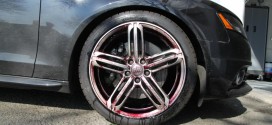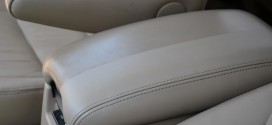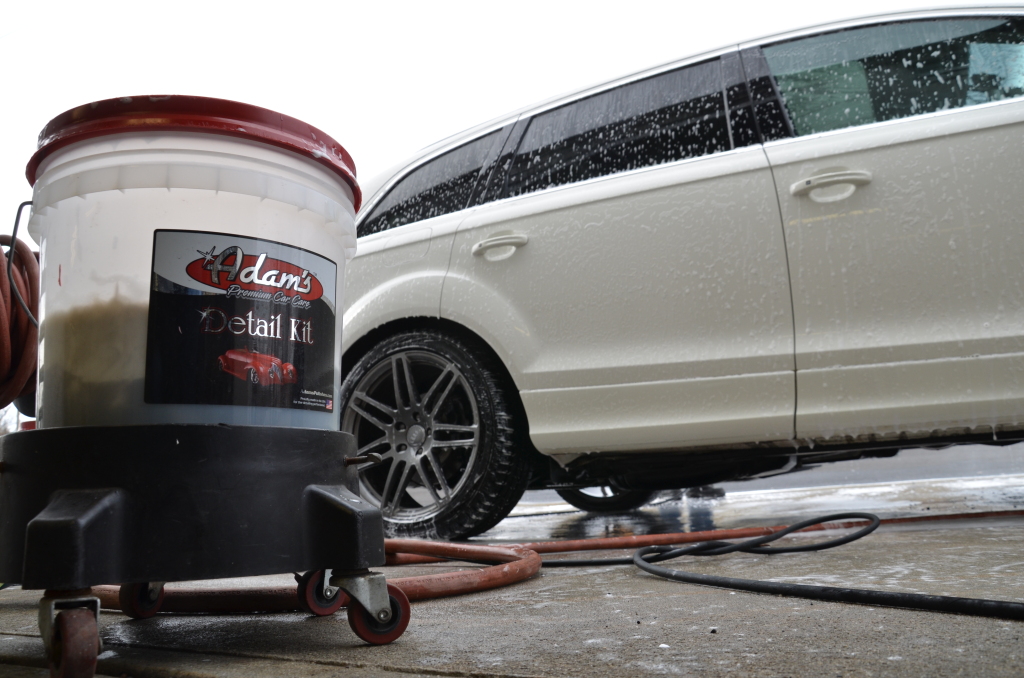Chances are that at some point in its life, a vehicle will have at least one mishap that will result in the need for it, or at least part of it, to be to be refinished. It is important to be able to identify any portion of a vehicle that has been refinished or has had bodywork to eliminate potential problems with the customer after his vehicle has been detailed.
THINGS HAPPEN
Problems can occur with a vehicle’s paint and body long before it ever reaches a dealership. There may have been a problem on the paint assembly line where the finish is not quite up to standard and the vehicle is sent through the factory spray booth again. Cars may be banged around on ships transporting them from overseas or in a holding yard and will need to be fixed. Cars being transported on carriers may be scratched, or have paint-damaging fluids leak over them from cars above. Sometimes these vehicles are repaired perfectly, but not always. When they are not perfectly repaired, a detailer could bear the wrath of a customer who does not think that his car came out the way it should.
HOW TO SPOT A REFINISH
You may save yourself a great deal of headaches and confusion if you can determine whether a portion of a vehicle has been repainted or has had bodywork performed. Good vision and knowing what to look for are the main requirements, but having an instrument that measures exactly how much paint is on the vehicle is also very important.
A useful piece of equipment to measure the paint film is an electronic paint thickness gauge or an ETG. It is made by Pro Motor Car products in Clearwater, FL. This instrument accurately measures the thickness of the paint film. Knowing how much paint is on the vehicle will quickly tell you if that portion of the vehicle has been refinished.
HOW MUCH IS TOO MUCH?
The electronic paint thickness gauge will read in Mils (1/1000th of an inch) or Microns (1 millionth of a meter). Regardless of which increment you choose, there are some guidelines as to how much is too much.
For example, a new BMW will have a typical total film thickness of about 120 microns, which equals 4.72 mils. Some manufacturers will produce vehicles with slightly more, some slightly less paint. If you take 5 mils as an average paint thickness, you have a guideline to determine how much is too much.
The ETG is the most accurate tool of its kind and is very user friendly. Turn it on, select your increment (mils or microns), hold the probe flat against the panel, and look at the reading. You need to go around the vehicle and take two or three readings per panel. To go over the entire car will only take about two minutes and the time spent may help you later on. If your readings are consistently in the 4 to 6.5 mil range, or up to 165 microns, you are probably working with factory paint.
If you have a panel on which the readings shoot up to 8 or 9 mils, or over 200 microns, you are probably working with a vehicle with some type of refinish. This tells you to examine that part of the vehicle more carefully to look for things that you may not be able to fix with a simple detail. If a panel was replaced, however, the readings will probably be in the range of factory specs, so having good vision and knowing what to look for remain the most important tools in identifying a refinished or non-factory finished panel.
POTENTIAL PROBLEMS
If a refinish job was done well you don’t have to worry about it. Sometimes there is no more beautiful a sight than a great aftermarket paint job. The paint looks like glass and has a shine and clarity that is of show-car quality. If the whole vehicle was repainted that is fine. But if it wasn’t, how does the original paint look next to the refinish paint? If a refinish job was done well, the paint on the part of the car that was refinished may look significantly better than the original paint on the rest of the car. On the other hand, there are many potential refinish problems, which may make the paint on the portion of the vehicle that was refinished look much poorer than the paint on the rest of the vehicle.
Being a painter myself, I know how difficult it is to produce a factory, or better-than-factory, finish. There are dozens of things that must go correctly or you risk compromising the job. If one thing goes wrong it may stick out like a sore thumb. The problem is that when detailing a car that has been poorly refinished, the customer tends to blame the detailer for not correcting a paint problem, regardless of whether or not it was correctable through the normal detailing process.
paint refinish examples
An example of a run in the clear coat.
This may be repairable to a degree.
An example of a base-coat run.
The paint pooled together and ran,
causing a change in the color.
NON-REPAIRABLE PAINT PROBLEMS
Let’s start by looking at some “non-repairable” problems in refinish work:
Color Match
If the color is off, it’s off. This is a problem in the base coat, which underlies the clear coat. You do not buff the base, you only buff clear coat. There are several reasons why the color may be “off.” The paint may not have been mixed or sprayed correctly, or it may not have been blended into the adjacent panel to hide the color difference. Metallic flakes in the base coat may also lie at a different angle on the refinish panel, causing light to reflect differently and that may shift the color.
Sand Scratch
Swelling This is common and refers to fine, sandpaper-caused scratches in the bodywork where the solvents from the layers of paint (primers, base coat, and clear coat) have penetrated those fine scratches and caused them to swell. This will show through the layers of paint and may appear to be scratches that the customer thinks can be removed by buffing. They cannot. Blotches, Mottling or Striping Some paints have a high metallic content and must be sprayed very carefully to match the factory appearance. If these metallic flakes lay the wrong way, it may look blotchy or have the appearance of stripes going across a panel where the metallics have pooled together. This may also shift the color. Again, this is in the base coat and there is nothing that can be done except to re-do the entire panel.
Cracking
If a paint surface gets too thick or too much paint has been applied to one area, it may crack or split over time. This also may appear to be a scratch, but upon careful examination you will determine that the paint film is cracked and cannot be buffed out.
Blisters or Solvent Pop
If you do not allow paint to flash or start to dry between coats, you may get a blistering effect, or what is called solvent pop. The solvents must escape and evaporate. If the solvents are trapped in the paint they eventually will break out by breaking the paint film. They may simply look like dots, pinholes, or small round deposits on the top of the paint surface. Customers will want to know why they are still there after the detail. Hazing or Cloudiness (Die Back) Painters usually buff, or even wet-sand then buff, a paint job after it is completed. Sometimes a body man with limited buffing skills and experience will be too harsh on a fresh paint job and overheat the new clear coat. This may not show up right away but over time that panel will lose its luster and gloss and never look as good as the rest of the vehicle. Again, this is something the customer may blame you for and it is not your fault.
Lack of Gloss (Dull)
Some shops use cheaper paint that does not hold up, dries out and loses its shine. The paint job may look good for a while, but over a short period of time oxidation will occur. This will be seen more in a single stage paint repair.
Peeling or Bubbling
If a surface was not prepared correctly and there was some grease or oil deposit left on it before refinishing, the paint will not stick. It may start to lift or bubble. The customer may not see these bubbles, but when you proceed to buff the vehicle you may rip a piece off or tear the paint film because it was weak to begin with. You will most certainly get the blame for this.
There are many things that have to be done correctly to produce a factory-like finish. When paint does not look the way it is supposed to, a customer will call on a detailer to make his car look like new. If the results do not meet the customer’s expectations, you may have given yourself a bad Above: An example of a run in the clear coat. This may be repairable to a degree. Above right: An example of a base-coat run. The paint pooled together and ran, causing a change in the color. name. It is so important to be able to see if a vehicle has been repainted, not only to cover yourself, but also to turn the situation into a more profitable detail.
VISUALLY INSPECT
I can’t stress enough how important it is to look over the vehicle with the customer before you start working on it. If you have the electronic paint thickness gauge, use it! Let the customer see that you know what you are doing. This tool adds to your credibility and it allows you to measure the paint along with visually inspecting it.
Open the doors. Look for overspray or tape lines in the doorjambs. Open the hood and trunk. Look for rough edges and limited coverage in these areas. Look for overspray on glass. Look for leftover masking tape. These are telltale signs. I do this on every job. I also look for things that I know won’t be part of the regular detail. I want to find uncorrectable things like I have just mentioned, but I also want to find “correctable” refinish problems which will be more profitable and produce a much better looking vehicle.
REPAIRABLE PAINT PROBLEMS[/b]
There are a number of refinish problems that can be perfectly corrected, or greatly improved, but almost always at a higher cost to the customer:
Overspray
This is one of the most common things in a refinish situation. Even if the area of repair is perfect, there may be overspray in areas that were not painted. This is simply a case of the vehicle not being covered enough to protect other areas from overspray settling. Many times this overspray can be clayed, then polished to regain the clarity and smoothness of the panel.
Heavy Orange Peel
This actually looks like the skin of an orange. Orange peel, to a degree, is acceptable. It is even designed into a factory finish, but too much hurts the gloss and clarity of the finish. Sometimes it can be compounded and polished out, but many times it will have to be wet sanded to “knock it down” then compounded and polished to remove it or lighten it.
Sags or Runs
This is a pooling of the clear coat to the point that it will sag or run down the panel. This will always need to be wetsanded rather aggressively. A great deal of skill and patience is involved, but it can be repaired.
Dry Spray
This will have a grainy appearance, rough feel, and a general lack of gloss. Sometimes this can be wet-sanded and buffed, if there is enough clear on the panel. Sometimes the clear is too thin and not much can be done.
Dirt or Dust in the Clear
Small, or sometimes large, particles will settle onto the paint surface while it is still wet. There is nothing that can be done with this until the finish has dried and cured. Many times you can “nib” these particles off with a small sanding block, then buff out. If there are only a few dirt nibs this is fairly easy, but if the entire panel is covered, the whole panel will have to be wet-sanded and buffed.
Fish Eyes or Cratering
This is caused by silicone or oil contamination in the air, or already on the surface of the vehicle from not being cleaned properly. The silicone particles push the clear coat molecules out of the way and form what looks like a depression or a crater in the clear coat. This is much more difficult to repair than a dirt nib because it is usually deep in the surface and too much sanding to level it out may break through into the base coat.
THE DETAILERS PROBLEM
As soon as you accept the job to detail a customer’s vehicle, you are expected to make it look as close to new as possible. Customers who are not made aware of refinish paint problems may not be happy with the outcome of the job. If the vehicle is not uniform in its appearance, or has an imperfection that you could not remove, you will more than likely be given the blame.
You should strive to train yourself to become a paint expert to enable you to address most paint problems. The customer will not always be happy to hear what you have to say, but you will be perceived as a true professional and paint expert, and maybe make some jobs more profitable along the way.
In next month’s issue, we will look at the prospects of you performing some refinishing yourself. Is it profitable? Is it difficult? What is involved and which jobs should you let a body shop handle?
Kevin Farrell owns and operates Kleen Car, a full-service auto detailing business located in New Milford, NJ. Kevin is also an instructor for a detailing program he developed for, and in conjunction with, BMW of North America. His background includes auto dealership experience and training through DuPont, General Motors, and I-Car.
Detailing Products
Copyright © 2004 by Kevin Farrell
 Detailer's Domain The Source for All Your Car Care Needs
Detailer's Domain The Source for All Your Car Care Needs



